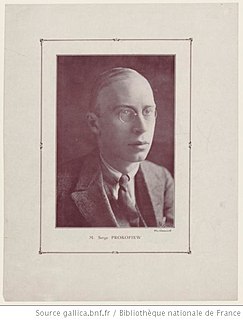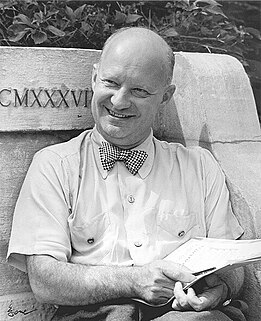Related Research Articles

Anzac Day is a national day of remembrance in Australia and New Zealand that broadly commemorates all Australians and New Zealanders "who served and died in all wars, conflicts, and peacekeeping operations" and "the contribution and suffering of all those who have served". Observed on 25 April each year, Anzac Day was originally devised to honour the members of the Australian and New Zealand Army Corps (ANZAC) who served in the Gallipoli Campaign, their first engagement in the First World War (1914–1918).

Sergei Prokofiev wrote his Symphony No. 5 in B-flat major, Op. 100, in Soviet Russia in one month in the summer of 1944.

Mass is a musical theatre work composed by Leonard Bernstein with text by Bernstein and additional text and lyrics by Stephen Schwartz. Commissioned by Jacqueline Kennedy, it premiered on September 8, 1971, conducted by Maurice Peress and choreographed by Alvin Ailey. The production used costume designs by Frank Thompson. The performance was part of the opening of the John F. Kennedy Center for the Performing Arts in Washington, D.C. Mass premiered in Europe in 1973, with John Mauceri conducting the Yale Symphony Orchestra in Vienna.

Richard James Gill was an Australian conductor of choral, orchestral and operatic works. He was known as a music educator and for his advocacy for music education of children.

Ross Edwards is an Australian composer of a wide variety of music including orchestral and chamber music, choral music, children's music, opera and film music. His distinctive sound world reflects his interest in deep ecology and his belief in the need to reconnect music with elemental forces, as well as restore its traditional association with ritual and dance. He also recognises the profound importance of music as an agent of healing. His music, universal in that it is concerned with age-old mysteries surrounding humanity, is at the same time connected to its roots in Australia, whose cultural diversity it celebrates, and from whose natural environment it draws inspiration, especially birdsong and the mysterious patterns and drones of insects. As a composer living and working on the Pacific Rim, he is aware of the exciting potential of this vast region.

The Te Deum by Hector Berlioz (1803–1869) was completed in 1849. Like the earlier and more famous Grande Messe des Morts, it is one of the works referred to by Berlioz in his Memoirs as "the enormous compositions which some critics have called architectural or monumental music." While the orchestral forces required for the Te Deum are not as titanic as those of the Requiem, the work calls for an organ that can compete on equal terms with the rest of the orchestra. It lasts approximately fifty minutes and derives its text from the traditional Latin Te Deum, although Berlioz changed the word order for dramatic purposes.
William Barton is an Aboriginal Australian didgeridoo player. He was born in Mount Isa, Queensland on 4 June 1981 and learned to play from his uncle, an elder of the Wannyi, Lardil and Kalkadunga tribes of Western Queensland. He is widely recognised as one of Australia's finest traditional didgeridoo players and a leading didgeridoo player in the classical world.
Andrew Ford is an English-born Australian composer, writer and radio presenter.
Pietari Inkinen is a Finnish violinist and conductor.

When Lilacs Last in the Dooryard Bloom'd: A Requiem for those we love is a 1946 oratorio by composer Paul Hindemith, based on the poem of the same name by Walt Whitman. Conductor Robert Shaw and the Robert Shaw Chorale commissioned the work after the 1945 death of President Franklin D. Roosevelt. It received its world premiere on May 14, 1946 at New York City Center, with the Collegiate Chorale conducted by Shaw and soloists Mona Paulee, contralto, and George Burnson, baritone. Paulee performed the work again with bass-baritone Chester Watson and the CBS Symphony Orchestra for the work's first recorded broadcast on CBS Radio on June 30, 1946.
Carl Crossin OAM is an Australian choral conductor, educator and composer. He is a graduate of the Sydney Conservatorium of Music and the University of Adelaide. He was a director of the Elder Conservatorium of Music in the University of Adelaide in 2010-14.

Allan Zavod was an Australian pianist, composer, jazz musician and occasional conductor whose career was mainly in America.
Benjamin Northey is an Australian conductor, musician and arranger. He has been Chief Conductor of the Christchurch Symphony Orchestra in New Zealand, since 2015. He is also the Principal Conductor in Residence of the Melbourne Symphony Orchestra since 2020. He was previously the Associate Conductor of the Melbourne Symphony Orchestra from 2010-2019.
Ghost Ranch is a three-movement orchestral composition by the American composer Michael Daugherty. Inspired by the life and work of artist Georgia O'Keeffe, the title is derived from the name of O'Keeffe's New Mexico summer home, Ghost Ranch. The piece was commissioned by BBC Radio 3, completed in 2005, and premiered February 8, 2006 in Poole, United Kingdom, with the Bournemouth Symphony Orchestra led by conductor Marin Alsop.
"Symphony No. 1 in 20 Keys " is a five-movement polytonal symphony for large orchestra written in 2014 by Matthew de Lacey Davidson. Its total duration is approximately 35 minutes.

The Great War Symphony is a choral symphony by the British composer Patrick Hawes written to commemorate the centenary of the First World War.
Soundings is an orchestral composition by the American composer Elliott Carter. The work was commissioned by the Chicago Symphony Orchestra for their final season with the conductor Daniel Barenboim as music director. It was first performed on October 6, 2005 at the Symphony Center, Chicago, by Barenboim and the Chicago Symphony Orchestra.
James Ledger is an Australian composer of contemporary classical music, and senior lecturer in composition at the Conservatorium of Music at the University of Western Australia, where he is Chair of Orchestral Composition.
Stuart Greenbaum is an Australian composer and professor of music composition at the University of Melbourne. He is currently the Head of Composition at the Melbourne Conservatorium of Music.
Murray Peter Khouri was a New Zealand and Australian classical clarinettist.
References
- 1 2 3 4 Ledger, James (2015). War Music: Programme Note. Retrieved May 6, 2016.
- 1 2 McCallum, Peter (April 23, 2015). "Anzac Day Salute, Sydney Symphony review: Trans-Tasman commissions honour Anzac legacy". The Sydney Morning Herald . Retrieved May 6, 2016.
- 1 2 McCarthy, James (April 26, 2015). "Review: ANZAC Day Salute (Sydney Symphony)". Limelight . Retrieved May 6, 2016.
- ↑ Boon, Maxim (April 21, 2015). "Screaming from the shore". Limelight . Retrieved May 6, 2016.
- ↑ Dart, William (April 25, 2015). "Concert Review: Spirit of Anzac". The New Zealand Herald . Retrieved May 6, 2016.